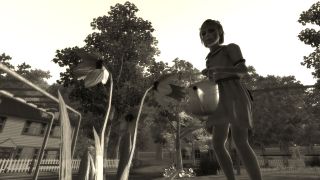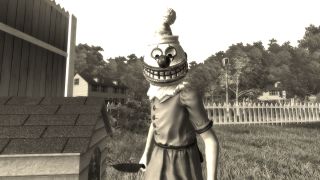Why I Love Fallout 3's Tranquility Lane
VATS entertainment.

People will tell you the strangest and best parts of Bethesda RPGs are the sidequests, and sometimes that's true. (It certainly was in Oblivion.) But one of the most Wild Wasteland moments in Fallout 3 is part of the main storyline, sitting right there on the critical path.

In Why I Love, PC Gamer writers pick an aspect of PC gaming that they love and write about why it's brilliant. This week, Jody appreciates Fallout 3 at its most twisted.
Your quest in Fallout 3 is to find your dad, Liam Neeson. It's a better hook for an open world game than the search for your son in Fallout 4, because everyone knows Liam Neeson can take care of himself. Bouncing across the Capital Wasteland, you're free to take your time—fight fire ants, help an inexplicably Canadian lady research her book—safe in the knowledge you can return to Dad Quest later on.
You finally track the deadbeat down to Vault 112, where you expect some kind of dungeon crawl, maybe a fight with some mutants or remnant Vault dwellers. You find something else entirely.
Vault 112's inhabitants have spent the last 200 years in a simulation, bodies suspended while their minds experience a series of pleasant virtual realities. Your dad went in to talk to the scientist who built it, Stanislaus Braun, and the only way to get him out is to follow. As the headset lowers over your face, the familiar loading screen message "PLEASE STAND BY" appears, to be replaced by the sedate black-and-white street called Tranquility Lane.
In this white picket fence American Dream, Fallout 3 becomes an episode of The Twilight Zone. While most of the residents are ignorant of their true nature, playing out their good neighbour roles in a place where there was no war and there is no wasteland, one is different. A little girl named Betty, watering flowers with her dog in the middle of this circular street, is aware of the real world. Her voice slips, becoming that of the elderly scientist Braun, and things get extremely Village of the Damned.
Braun's in charge of the simulation, a virtual god, and it's gone to his head. He's begun making the dream into a nightmare, tormenting the inhabitants for kicks then resetting reality, over and over, and will only hand over your dear old dad if you take part in his twisted game. You're a child too in the simulation, which makes it even more messed up when Braun's game escalates. The first task is making a boy cry; by the end you're committing atrocities.

Fallout is at its best when it's offering multiple solutions to quests, letting you write your personality across its design. The first two games had three solutions for almost every problem—violent, diplomatic, or sneaky—but Fallout 3 often reduces that to two—good karma and bad karma. In Tranquility Lane, there are still good and bad karma options, but the bad karma ones branch like a network of arteries.
The biggest gaming news, reviews and hardware deals
Keep up to date with the most important stories and the best deals, as picked by the PC Gamer team.
When Braun tells you to murder Mabel, it's suddenly a Hitman level in miniature, her house overflowing with deathtraps. You can sabotage a chandelier to fall on her, or go full Looney Tunes with a roller skate at the top of the stairs. You can talk to the neighbours to learn she loves to bake pies, then rig her gas oven to explode. Or you can hack her house's security to lock the doors and turn her Mr. Handy robot hostile, then evade the thing while it flamethrowers and saws her to death.
To top that, for a finale Braun tells you to become "the Pint-Sized Slasher." You find an evil clown mask and a knife, then kill every remaining adult in Tranquility Lane.

Fallout is a black comedy from the moment you see US soldiers gunning down Canadians in the street during the first game's intro, but that dark sense of humor was lost in the sequel—replaced by sex jokes and pop culture references. Tranquility Lane brings it back. I can't help but laugh when I'm the Pint-Sized Slasher. The jaunty music, the bright surroundings, the clown mask, all absurdly contrasted with the simulated citizens who come apart at the joints just like the raiders you shoot for the other 50 hours you spend in Fallout 3.
"Wasn't it fun?" Braun asks afterwards. Sure it was. I was killing people in a videogame, that's what I signed up for. There's no way to spare them. The good karma choice is to activate a failsafe that kills the residents in real life, ending their torment while leaving Braun alone in this hell of his own making. Which is the darkest option yet. There's no way out of Tranquility Lane without blood on your hands.

Jody's first computer was a Commodore 64, so he remembers having to use a code wheel to play Pool of Radiance. A former music journalist who interviewed everyone from Giorgio Moroder to Trent Reznor, Jody also co-hosted Australia's first radio show about videogames, Zed Games. He's written for Rock Paper Shotgun, The Big Issue, GamesRadar, Zam, Glixel, Five Out of Ten Magazine, and Playboy.com, whose cheques with the bunny logo made for fun conversations at the bank. Jody's first article for PC Gamer was about the audio of Alien Isolation, published in 2015, and since then he's written about why Silent Hill belongs on PC, why Recettear: An Item Shop's Tale is the best fantasy shopkeeper tycoon game, and how weird Lost Ark can get. Jody edited PC Gamer Indie from 2017 to 2018, and he eventually lived up to his promise to play every Warhammer videogame.
Most Popular



